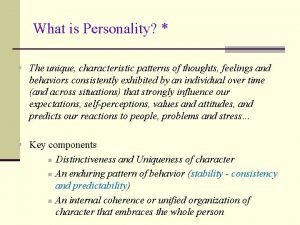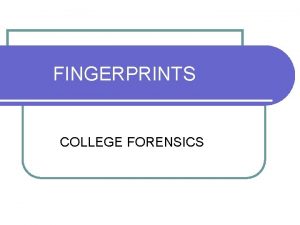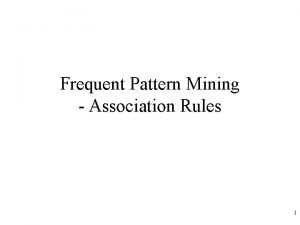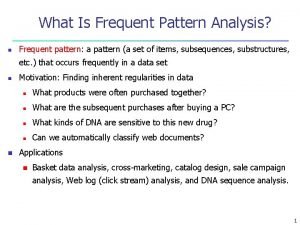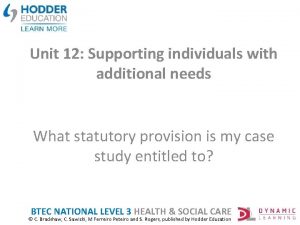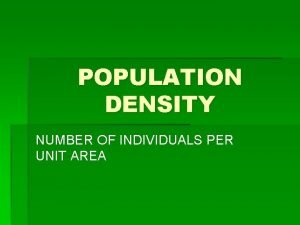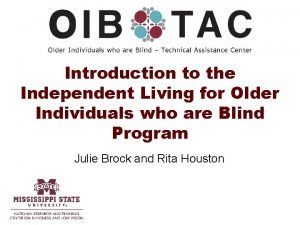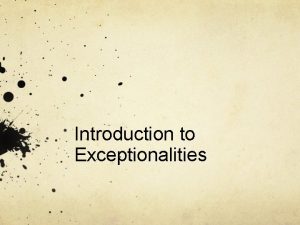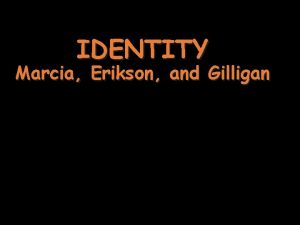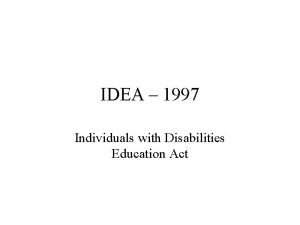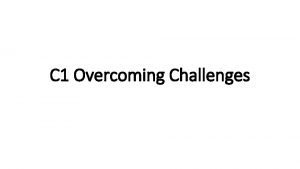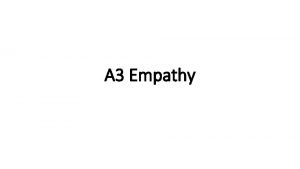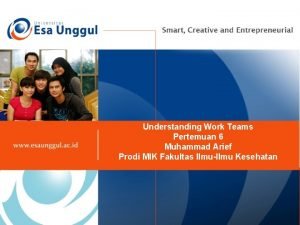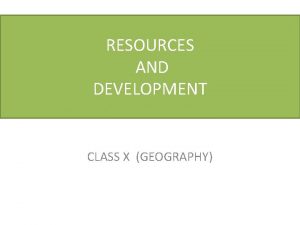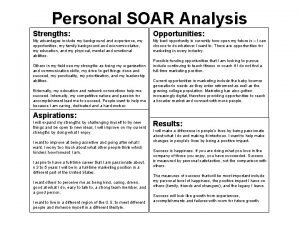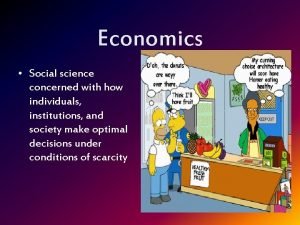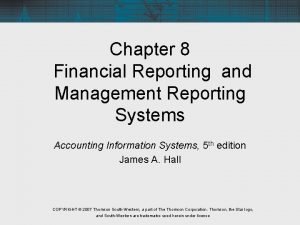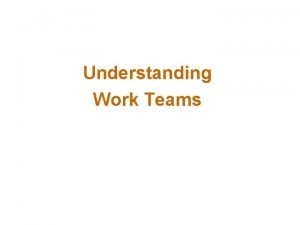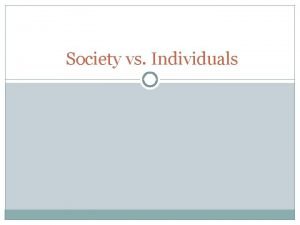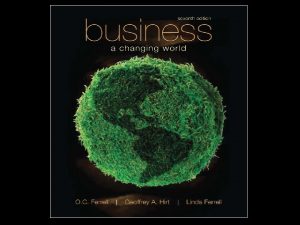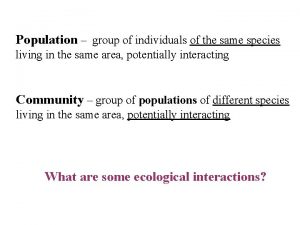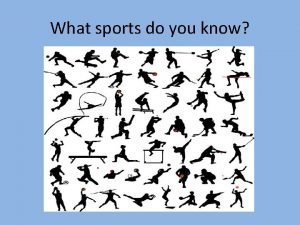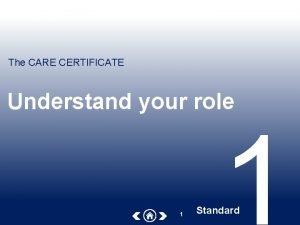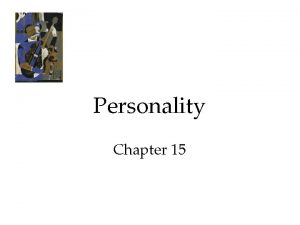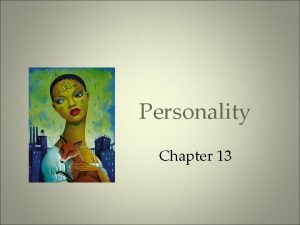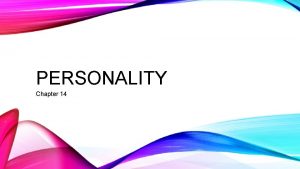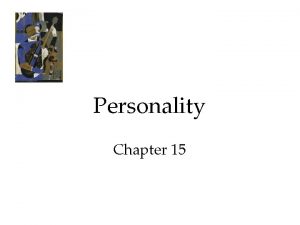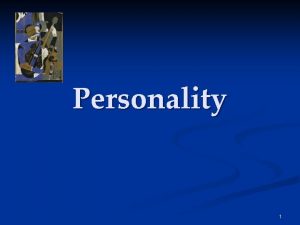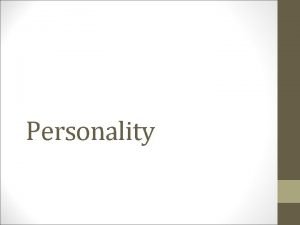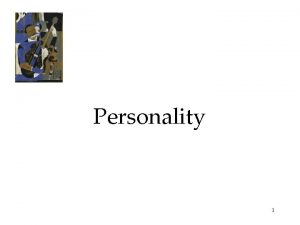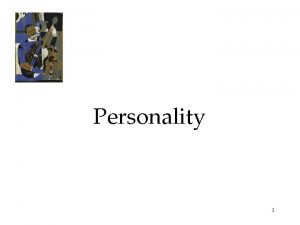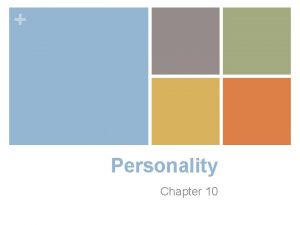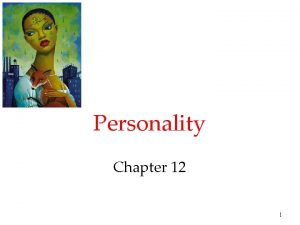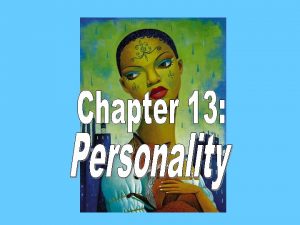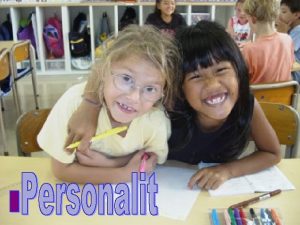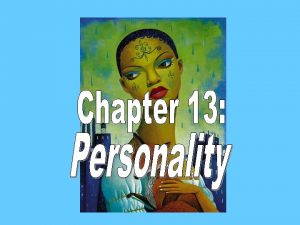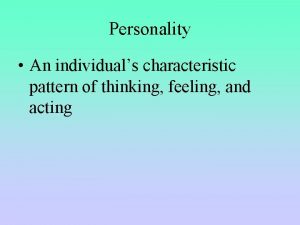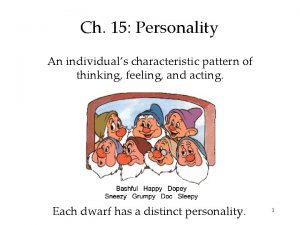PERSONALITY Chapter 14 Personality Is individuals characteristic pattern






































- Slides: 38

PERSONALITY Chapter 14

Personality • Is individual’s characteristic pattern of thinking, feeling, and acting Psychodynamic theories • Posit that behavior is dynamic interaction between conscious and unconscious mind Humanistic approach • Focus on inner capacities for growth and self-fulfillment Trait theories • Examine characteristic patterns of behavior Social-cognitive theories • Explore interaction between traits and social context PERONALITY

PERSONALITY Freud’s Psychoanalytic Perspective: Perspective Exploring the Unconscious • Observed patients whose disorders had no clear physical explanations • Concluded their problems reflected unacceptable thoughts and feelings, hidden away in the unconscious mind

PERSONALITY Psychoanalysis • Freud’s theory of personality that attributes thoughts and actions to unconscious motives and conflicts; the techniques used interpret unconscious tensions Unconscious • A reservoir of mostly unacceptable thoughts, wishes, feelings, and memories; According to contemporary psychologists, information processing of which we are unaware. Free association • In psychoanalysis, a method of exploring the unconscious in which the person relaxes and says whatever comes to mind, no matter how trivial or embarrassing. Id • A reservoir of unconscious psychic energy that, according to Freud, strives to satisfy basic sexual and aggressive drives. The id operates on the pleasure principle, demanding immediate gratification

PERSONALITY • Psychologists have used an iceberg image to illustrate Freud’s idea that the mind is mostly hidden beneath the conscious surface. • Note that the id is totally unconscious, but ego and superego operate both consciously and unconsciously. • Unlike the parts of a frozen iceberg; however, the id, ego, and superego interact.

PERSONALITY Freud believed that personality results from the mind’s three systems. • Id: Operates on pleasure principle; unconsciously strives to satisfy basic drives to survive, reproduce, and aggress • Ego: Operates on reality principle; seeks to realistically gratify id’s impulses to bring long-term pleasure; contains perceptions, thoughts, judgments and memories • Superego: Focuses on ideal behavior; strives for perfections; acts as moral conscious

PEROSNALITY Freud’s Psychosexual Stages Stage Focus Oral (0– 18 months) Pleasure centers on the mouth—sucking, biting, chewing Anal (18– 36 months) Pleasure focuses on bowel and bladder elimination; coping with demands for control Phallic (3– 6 years) Pleasure zone is the genitals; coping with incestuous sexual feelings Latency (6 to puberty) A phase of dormant sexual feelings Genital (puberty on) Maturation of sexual interests

PERSONALITY Defense Mechanisms • Ego protects itself with tactics that reduce and redirect anxiety by reality distortion (defense mechanisms). • Defense mechanisms function indirectly and unconsciously. • Repression underlies all other defense mechanisms. It is sometimes incomplete and may be manifested as symbols in dreams or slips of the tongue. • Freud believed that repression, the basic mechanism that banishes anxiety-arousing impulses, enables other defense mechanisms

PERSONALITY Defense Mechanism Unconscious Process Employed to Avoid Anxiety. Arousing Thoughts or Feelings Example Regression Retreating to a more infantile psychosexual stage, where some psychic energy remains fixated. A little boy reverts to the oral comfort of thumb sucking in the car on the way to his first day of school. Reaction formation Switching unacceptable impulses into their opposites. Repressing angry feelings, a person displays exaggerated friendliness. Projection Disguising one’s own threatening impulses by attributing them to others. “The thief thinks everyone else is a thief” (an El Salvadoran saying). Rationalization Offering self-justifying explanations in place of the real, more threatening unconscious reasons for one’s actions. A habitual drinker says she drinks with her friends “just to be sociable. ” Displacement Shifting sexual or aggressive impulses toward a more acceptable or less threatening object or person. A little girl kicks the family dog after her mother sends her to her room. Denial Refusing to believe or even perceive painful realities. A partner denies evidence of his loved one’s affair.

PERSONALITY The Neo-Freudian and Later Psychodynamic Theorists • Neo-Freudians • Accepted many of Freud’s ideas • Placed more emphasis on conscious mind and on social motives than sexual or aggression related ones • Contemporary psychodynamic theorists • Reject Freud’s emphasis on sexual motivation • View mental life as primarily unconscious • Contend childhood social experiences influence adult personality and attachment patterns • Many believe species’ shared evolutionary history shaped some universal predispositions (archetypes)

PERSONALITY Alfred Adler • “The individual feels at home in life and feels his existence to be worthwhile just so far as he is useful to others and is overcoming feelings of inferiority” (Problems of Neurosis, 1964). • Proposed inferiority complex • Agreed with Freud about childhood importance • Believed childhood social, not sexual tensions crucial for personality formation

PERSONALITY Karen Horney • “The view that women are infantile and emotional creatures, and as such, incapable of responsibility and independence is the work of the masculine tendency to lower women’s self- respect” (Feminine Psychology, 1932). • Theorized childhood anxiety triggers desire for love and security • Countered assumption that women have weak superegos and suffer penis envy • Agreed with Freud about childhood importance • Believed childhood social, not sexual tensions crucial for personality formation

PERSONALITY Carl Jung • “From the living fountain of instinct flows everything that is creative; hence the unconscious is the very source of the creative impulse” (The Structure and Dynamics of the Psyche, 1960). • Placed less emphasis on social factors and agreed with idea of influence of unconscious • Proposed collective unconscious (archetypes) derived from species’ universal experiences • Ex: Rooting for the underdog

PERSONALITY Assessing Unconscious Processes • Projective test • Personality test that provides ambiguous stimuli designed to trigger projection of one’s inner dynamics and reveal unconscious motives • Most widely used projective test, a set of 10 inkblots, designed by Hermann Rorschach • Seeks to identify people’s inner feelings by analyzing their interpretations of the blots; attempts to address low reliability and validity in most areas addressed with research-based, computer-aided tool THE RORSCHACH TEST Some who use this test are confident that the interpretation of ambiguous stimuli will reveal unconscious aspects of the test-taker’s personality

PERSONALITY Assessing Unconscious Processes • Thematic Apperception Test (TAT) • Projective test in which people express their inner feelings and interests through the stories they make up about ambiguous scenes

PERSONALITY Modern research contradicts many of Freud’s ideas • Development is lifelong, not fixed in childhood • Parental influence is overestimated and peer influence is underestimated • Oedipus complex questioned • Gender identity develops earlier than Freud theorized and is possible without influence of same-sex parent in home • Belief that dreams disguise and fulfill wishes is disputed, as is idea that suppressed sexuality causes psychological disorders • Freud’s scientific methodology is criticized • After-the-fact explanations of characteristics fail to predict behaviors and traits

PERSONALITY Evaluating Freud’s Psychoanalytic Perspective and Modern Views of the Unconscious Freud is credited with: • • Drawing attention to the vast unconscious Struggling to cope with sexuality Addressing conflict between biological impulses and social restraints Identifying forms of defense mechanisms and unconscious terrormanagement defenses

PERSONALITY Modern Research does not support many of Freud’s specific ideas. • Modern research challenges: • Freud’s concept of repression • View of the unconscious as a collection of repressed and unacceptable thoughts, wishes, feelings, and memories • Difficulty of scientifically testing Freud’s concepts • Many research psychologists now think of the unconscious as information processing that occurs without awareness. • Unconsciousness involves • Schemas, priming, right-hemisphere activity, implicit memories, emotions, and stereotypes • Research supports two of Freud’s defense mechanisms: reaction formation and projection

PERSONALITY Humanistic Theories and Trait Theories Abraham Maslow’s Self-Actualizing Person • Maslow focused on potential for healthy personal growth and people’s striving for self-determination and self-realization • People motivated by hierarchy of needs and strive toward self-actualization and selftranscendence

PERSONALITY Humanistic Theories and Trait Theories Carl Rogers’ Person-Centered Perspective • Roger posited that growth-promoting environment characteristics are genuineness, acceptance, and empathy. • Unconditional positive regard and selfconcept are key components of theory

PERSONALITY Humanistic psychologists sometimes assessed personality using questionnaires to evaluate their self-concept. • Some rejected any standardized assessments and relied on interviews and conversations. • Rogers sometimes used questionnaires in which people described their ideal and actual selves, which was later used to judge progress during therapy. • ideal self – who we would like to be • Actual self – who we actually are

PERSONALITY Influences • Influenced counseling, education, child-raising, and management • Laid groundwork for positive psychology • Renewed interest in concept of self Criticisms • Presents vague and subjective concepts • Advances individualism and selfcentered values • Offers naively optimistic assumptions

PERSONALITY • Trait theorists • See personality as a stable and enduring pattern of behavior • Describe differences rather than trying to explain them • Use factor analysis to identify clusters of behavior tendencies that occur together • Suggest genetic predispositions influence many traits • Factor analysis • Statistical procedure used to identify clusters of test items to tap basic components of intelligence • Eysenck Personality Questionnaireextraversion and emotionality factors inevitably emerged as basic personality dimensions • Introvert – shy, keeps to themselves • Extrovert – outgoing, social


PERSONALITY Exploring Traits Biology and personality • Brain-activity scans of extraverts indicate they seek stimulation because normal brain arousal is relatively low. • Dopamine and dopamine-related neural activity tend to be higher in extraverts. Stigma of introversion • Introversion is often misunderstood as shyness, but introverted people often simply seek low levels of stimulation from their environment.

PERSONALITY Assessing Traits Personality inventory • Questionnaire on which people respond to items designed to gauge a wide range of feelings and behaviors; used to assess selected personality traits • Test items empirically derived, and tests objectively scored • But people can fake their answers to create a good impression, and the ease of computerized testing may lead to misuse of the tests. Example • Minnesota Multiphasic Personality Inventory (MMPI/Hathaway) • Translated into 100+ languages

PERSONALITY The Big Five Factors The Big Five personality factors (Costa and colleagues, 2011) currently offer the most widely accepted picture of personality • Genetic influences are similar in different nations. • Many genes, each having small effects, combine to influence traits. The Big Five Personality Traits • • • Conscientiousness Agreeableness Neuroticism Openness Extraversion (CANOE)

PERSONALITY Big Five Research Questions • How stable are these traits? • How heritable are they? • Do traits reflect differing brain structure? • Have these traits changed over time? • How well do these traits apply to various cultures? • Do the Big Five traits predict our actual behaviors?

PERSONALITY

PERSONALITY The Person-Situation Controversy Behavior is influenced by the interaction of our inner disposition with our environment. • In general, personality traits are stable and socially significant. • Personality traits are predictors of mortality, divorce, and occupational attainment. • Consistency of specific behaviors from one situation to another is weak; average behaviors are predictable • At any moment the immediate situation powerfully influences a person’s behavior.

PERSONALITY Social-Cognitive Theories and the Self Social-cognitive perspective (Bandura) • Views behavior as influenced by the interaction between people’s traits (including their thinking) and their social context • Emphasizes interaction of our traits with our situations • Applies principles of learning, cognition, and social behavior to personality

PERSONALITY Reciprocal Influences Reciprocal determinism • Describes interaction and mutual influence of behavior, internal personal factors, and environmental factors Interaction of individuals and environments: Internal personal factors • Different people choose different environments. • Personalities shape how people interpret and react to events. • Personalities help create situations to which people react.

PERSONALITY Assessing Behavior in Situations Social-cognitive theorists • Build on concepts of learning and cognition • Contend best way to predict behavior in a given situation is to observe that behavior in similar situations • Underemphasize importance of unconscious motives, emotions, and biologically influenced traits

PERSONALITY Exploring the Self • Exploration of self in psychology has long history • William James (1890) • Gordon Allport (1943) • Humanistic psychology • Psychology today • Self is one of most studied topics and viewed as center of personality • Consideration of possible selves motivates toward positive development; too intense focusing may lead to spotlight effect

PERSONALITY High self-esteem correlates with less pressure to conform, with persistence at difficult tasks, and with happiness. But the direction of the correlation is not clear. • Self-esteem is our feeling of self-worth • Self-efficacy is our sense of competence on a task

PSYCHOLOGY Costs of Self-Esteem • Excessive optimism • May lead to complacency • May prevent recognition of real risks • May be self-defeating when dealing with temptations • May be directed toward group (illusionary optimism)

PERSONALITY Costs of Self-Esteem • Blindness to one’s own incompetence • People are most overconfident when most incompetent; it takes competence to recognize competence • Self-serving bias • Involves a readiness to perceive self favorably • Suggests people accept more responsibility for good deeds than for bad, and for successes than for failure • Often creates a better-than-average effect • May underlie a range of conflicts

PERSONALITY • Some researchers propose two types of self-esteem • Defensive self-esteem is fragile, threatened by failure and criticism, and more vulnerable to perceived threats which feed anger and feelings of vulnerability. • Secure self-esteem is less fragile, less contingent on external evaluations, and more likely to achieve a greater quality of life.
 What is personality
What is personality Defense mechanisms examples
Defense mechanisms examples An individual characteristic pattern of thinking
An individual characteristic pattern of thinking Minutiae
Minutiae Patterns and pattern classes in digital image processing
Patterns and pattern classes in digital image processing Frequent pattern
Frequent pattern Frequent pattern
Frequent pattern Unit 12 supporting individuals with additional needs
Unit 12 supporting individuals with additional needs Photo/drawing of individuals/groups/institutions
Photo/drawing of individuals/groups/institutions Risk management for enterprises and individuals
Risk management for enterprises and individuals Gene pool
Gene pool What is the number of individuals per unit area
What is the number of individuals per unit area Individuals: an essay in descriptive metaphysics
Individuals: an essay in descriptive metaphysics Older individuals who are blind program
Older individuals who are blind program Individuals with exceptionalities
Individuals with exceptionalities James marcia
James marcia Individuals with disabilities education act of 1997
Individuals with disabilities education act of 1997 Enabling individuals to overcome challenges
Enabling individuals to overcome challenges Empathy theories johannes volkelt
Empathy theories johannes volkelt Turning individuals into team players
Turning individuals into team players Individuals
Individuals The process of attracting individuals on a timely basis
The process of attracting individuals on a timely basis Soar vs swot analysis
Soar vs swot analysis Economics is the social science concerned with
Economics is the social science concerned with Pseudo team meaning
Pseudo team meaning Individuals with access authority to general ledger
Individuals with access authority to general ledger Why have teams become so popular
Why have teams become so popular Individual vs society in a doll's house
Individual vs society in a doll's house Importance of secretary
Importance of secretary The activities that independent individuals groups
The activities that independent individuals groups Serving individuals and families
Serving individuals and families Serving individuals and families
Serving individuals and families Group of individuals of the same species
Group of individuals of the same species Healthy confident individuals
Healthy confident individuals Better health for individuals
Better health for individuals It is a sport in which participants compete as individuals
It is a sport in which participants compete as individuals Understand your role care certificate
Understand your role care certificate Individuals and families diverse perspectives
Individuals and families diverse perspectives Johannes volkelt empathy theory
Johannes volkelt empathy theory
